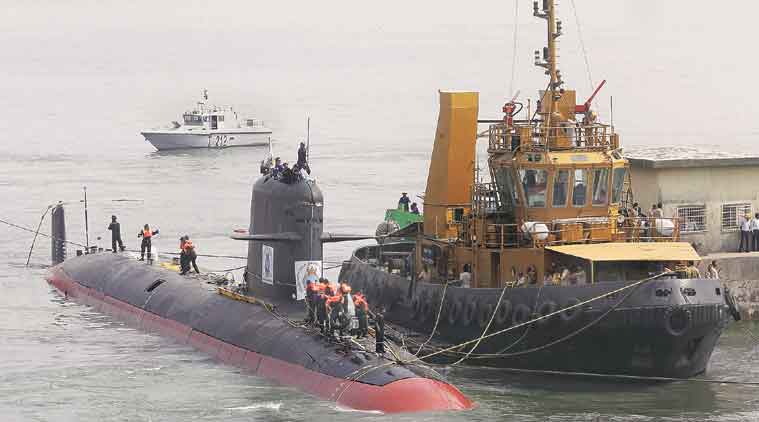

To coordinate next year’s Golden Jubilee celebrations of the induction of the first submarine in the Navy, more than 100 retired officers of the submarine branch started a WhatsApp group last month. This group, which includes three-star officers who have spent decades with submarines, went abuzz at midnight last Tuesday after The Australian newspaper reported that 22,400 pages of documents pertaining to India’s Scorpene submarine programme, called Project-75, had been leaked.
The veterans studied the few leaked pages — with redacted data — put out by the paper, and intense discussions followed in the group for the first three days. In the end, there was near unanimity that while such data being put out publicly was not a good thing, it did not affect Project-75 in any significant way.
Under Project-75, French company DCNS provides design and technology to public sector Mazagon Docks to make six Scorpene submarines, the first of which, INS Kalvari was put out for sea trials earlier this year. The hulls of the other five submarines have been cast, and they are scheduled to be commissioned by 2020.
Captain J S Malik, a retired submariner with 32 years of experience who served as Director of Submarine Operations in Navy Headquarters, said, “Most of this data is generic and belongs to Naval Staff Qualitative Requirements (NSQR) provided by the Navy to the French company, and ‘binding data’ for the product. It does not pertain to any specific submarine, and has limited usage for the adversary.”
But Defence Minister Manohar Parrikar and Ministry officials have repeatedly asserted that they are “prepared for the worst-case scenario”. What could be the areas of concern for the Navy?
 A part of the leaked papers.
A part of the leaked papers.
According to Commodore A Jai Singh, a retired submariner who was associated with Project-75 preparations at Navy Headquarters at the turn of the century, “the only thing, which if leaked out from the supplier, that can really compromise the operation of our submarines is the source code of the Fire Control System. It is a top secret thing which the DCNS doesn’t even share with the company providing the weapons. The Australian hasn’t claimed that it is in the possession of the software code, and besides that, everything else is not really going to matter.”
He added, “Just the generic technical specifications are little indication of a submarine’s operational capability. The element of stealth and superiority is how a navy operates its submarines with the equipment on board and therein lie the vital elements of secrecy essential for submarine operations.”
Three top Navy sources have confirmed to The Indian Express that the documents put out so far are not the same as the ones with the Navy. These are dated versions from a period well before the signing of the contract with DCNS in 2005. Navy officials assert that “we are no longer a buyer’s Navy but a builder’s Navy. Only six navies have successfully built ballistic missile submarines, including India. There is no need to be overly concerned as we have the capability of tweaking the design, and the weapon and sensor deployment capability to mitigate any risk from information being compromised.”
The Australian has reported being in possession of 10 types of secret information which compromises the Indian programme. The Indian Express went over each of them with experts to figure out what they mean, and how they could affect the Navy.
Stealth capabilities
Stealth capabilities pertain mainly to the acoustic signature of a submarine, and is a function of many things, including the submarine’s self-noise levels, the propeller configuration, the speed regimes underwater, the noise generated by on-board machinery, and the acoustic damping techniques used both on the hull and within the submarine. The harmonics produced by no two submarines are the same. These spot frequencies, unlike the range given in the documents, are recorded by special equipment after a submarine goes for sea-trials, and kept in the Ship Data Book, a top secret document kept with the captain of the submarine. This data is re-recorded after every major refit, as the harmonics change. In the case of a European design like the Scorpene, there would not be much to choose between contemporary designs of a relatively similar size which would operate in the same frequency ranges.
Frequencies at which submarines gain intelligence
Most modern submarine Electronic Search Measures (ESM) systems operate in a frequency range of 0.2 to 40 GHz, so to learn that Scorpenes operate in a similar frequency band is no compromise. Similarly, submarines are fitted with navigational radars with commercial applications, which operate in a particular frequency range worldwide. A modern submarine rarely, if ever, transmits at sea either from its radars or its sonars, or even its communication sets. A Naval officer who commanded a submarine for six years said that he used an active sonar only thrice in his tenure, that too only to test the equipment and validate the training of his staff.
Noise levels submarines could reach at certain speeds
Noise levels are a function of the submarine speed and the speed of rotation of a propeller, which is recorded during sea trials and noted in the Ship Data Book. The data put out is the NSQR limits given by the Navy to the designers that it should not exceed so many decibels at various speeds.
Diving depths, range and endurance
Range and endurance of all submarines are in the open domain. While specific depths may not be listed in the open specifications, most submarines the world over operate in a more or less similar depth envelope. Endurance of any submarine is dependent on its maximum patrol period, which determines the quantity of fuel carried. It varies between 50 and 60 days in the case of India’s submarines.
Magnetic, electromagnetic and infra-red data
Every submarine is demagnetised after construction and undergoes trials at the underwater ranges at Goa. The data for even the first submarine has not been recorded so far. This data is updated even if a submarine has stayed in a dry dock for a prolonged period. Rarely has a submarine been detected by an MRASW aircraft fitted with a Magnetic Anomaly Detector. Since submarines do not transmit, they are not vulnerable to detection in the e-m spectrum.
Specifications of the submarine’s torpedo launch system and combat system
The Navy has not selected the torpedo for the six submarines after the contract for Black Shark torpedoes from the Italian company WASS was cancelled following the VVIP helicopter controversy. Based on the choice of weapons and sensors on board, and the operating philosophy, the combat system would be programmed by the Navy, so there would be very little to be gained from the basic characteristics of the system. The secrecy lies in their programming by the Navy.
Speed and conditions needed for using the periscope
Modern submarines rarely plane to periscope depth except for the minimum time required to charge their batteries. This duration is also a function of the submarine’s mission profile, as well as the tactical exploitation of the platform in the prevailing operational scenario. Knowing the speed and conditions needed for using the periscope actually discloses little or no information about what the submarine is doing or intends to do.
Propeller’s noise specifications
Each propeller generates its own harmonics of noise which is determined after extensive trials, while the data put out is the generic NSQR data. Even a minor chip of 2-3 mm completely changes propeller noise. The propeller generates different noise at different speeds at varying depths and varying hydrological conditions. The submarine is equipped with cavitation meters, to assess the noise level and accordingly vary its speed or depth to find the most suitable depth and speed profile to operate at.
Radiated noise levels when the submarine surfaces
A submarine is unlikely to surface in an operational deployment, and will do so if required, only in friendly waters. In an emergency, if a submarine has no choice but to surface, its visual presence will be easier to detect than its acoustic signature.
Weapons data
Weapons used in peacetime during training and during war operate on totally different frequencies. The war-shots are launched on frequency hopping mechanism, unlike peacetime firing. A veteran submariner gave the example of the only test war-shot fired by him in 2003 off the coast of Mumbai which could not be recorded by any of the half a dozen Indian ships monitoring the firing, despite knowing the exact timing and the location of the target. Moreover, the Pakistan Navy is also in possession of the same Exocet missile which these Scorpenes will use.
[source;indianexpress]




